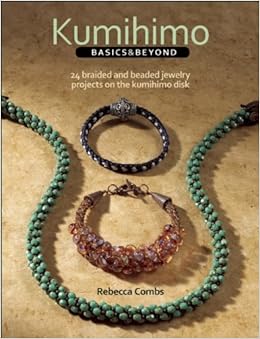Received a review copy of the new book by Rebecca Combs – Kumihimo Basics and Beyond yesterday.
From a “Braider First” perspective”
Very mixed feelings, on the one hand I like that the author has apparently worked very hard to be accurate and use more traditional terminology.
Ms Combs did supply some “kumihimo math” – but one has to remember that is only going to apply to these braids. For those who preferred to have more detailed materials lists, each braid does have a well done supply list for each pattern supplied in the book.
There is great eye candy, and while I do not really object to “heavily beaded braids” it was disappointing to have it all be “only” 8 element Kongo except for one 16 element project.
There were some other small details, but it did a bit better than most of the books and pattern presently offered in providing some finishing information.
With an SRP of $21.99 US, but already showing up discounted on Amazon, this will be one we likely not choose to stock. but will order if a customer really wants it at the price we can afford to sell.
From the Bead Jewelry Maker Perspective:
with thanks to Carolyn for sharing her view –
Caroyln wrote: “I also got a review copy of this book, thanks to my local bead shop’s partnership with Kalmbach and my status as resident kumihimo instructor. I found that the book is really geared to a beading audience, someone who is looking to expand their variety of jewelry making techniques as opposed to someone who is looking to start in the discipline of braiding. That being said, for that audience this may be the only book they will ever need, and is a starting point for those wishing to go truly beyond.
All the braids in the book are round braid/kongo gumi, so once you have the basics of that braid down you can complete any project in the book. There is a lot of good advice on making braids, and this may be the only book that shows you what common braiding mistakes look like so you can see how to correct them. It’s an excellent first braiding book for those interested in the disk. The only things I don’t like about the book is that she ends every braid by gluing it into a bead cap or cone, and the author doesn’t use a counterweight unless she’s also using beads. ”
We seem (Wheat & Carolyn) agree, tThis would not be a book for someone already comfortable with basics of beading and braiding and ready to grow their skills for more diverse pieces.
However for someone wanting an low cost entry level to the most basic of beaded braiding, it might be okay as it is already being offered at less than I can obtain it thru my distributor, so we will be referring folks to Amazon where possible
Me, I am saving my personal money for the upcoming Jacqui Carey book due in January. In fact, already on order with our distributor.
updated:


I also got a review copy of this book, thanks to my local bead shop’s partnership with Kalmbach and my status as resident kumihimo instructor. I found that the book is really geared to a beading audience, someone who is looking to expand their variety of jewelry making techniques as opposed to someone who is looking to start in the discipline of braiding. That being said, for that audience this may be the only book they will ever need, and is a starting point for those wishing to go truly beyond.
All the braids in the book are round braid/kongo gumi, so once you have the basics of that braid down you can complete any project in the book. There is a lot of good advice on making braids, and this may be the only book that shows you what common braiding mistakes look like so you can see how to correct them. It’s an excellent first braiding book for those interested in the disk. The only things I don’t like about the book is that she ends every braid by gluing it into a bead cap or cone, and the author doesn’t use a counterweight unless she’s also using beads.